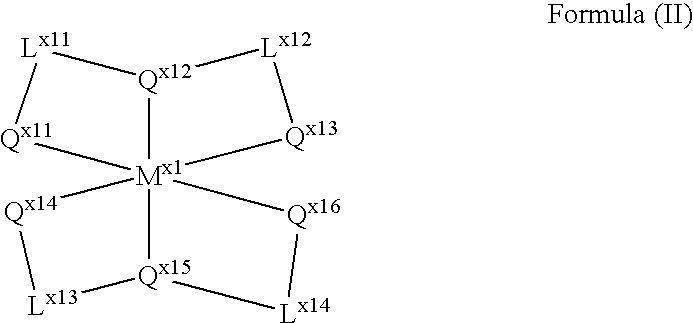Organic electroluminescent device
a technology of electroluminescent devices and organs, which is applied in the direction of thermoelectric devices, discharge tubes luminescnet screens, other domestic objects, etc., can solve the problems of insufficient durability of the devices disclosed in these patents and the possibility of performance variation, so as to reduce the necessary voltage and increase the driving durability
- Summary
- Abstract
- Description
- Claims
- Application Information
AI Technical Summary
Benefits of technology
Problems solved by technology
Method used
Image
Examples
example 1
[0519] The EL device of Example 1 was formed in the same manner as that of Comparative example 1, except that a compound P1 (shown above) was used in place of the compound P-A.
example 2
[0520] The EL device of Example 2 was formed in the same manner as that of Comparative example 1, except that a compound P3 (shown above) was used in place of the compound P-A.
(1) External Quantum Efficiency
[0521] Application of a direct current voltage to each of the electroluminescent device of the above Examples and Comparative examples to cause light emission by using a source measure unit (trade name: MODEL 2400, manufactured by Toyo Corporation). The brightness of the light emission was measured by a brightness meter (trade name: BM-8, manufactured by Topcon Corporation). The waveform of the light emission spectrum of the produced luminescent device was measured by using a multi-channel analyzer (trade name: PMA-11, manufactured by Hamamatsu Photonics K.K). Based on the measured data, the external quantum efficiency in the range of around 1,000 cd / m2 was calculated according to the brightness conversion method.
(2) Driving Durability: Brightness Half-Life Time
[0522] A con...
PUM
| Property | Measurement | Unit |
|---|---|---|
| temperature | aaaaa | aaaaa |
| temperature | aaaaa | aaaaa |
| temperature | aaaaa | aaaaa |
Abstract
Description
Claims
Application Information
 Login to View More
Login to View More - R&D
- Intellectual Property
- Life Sciences
- Materials
- Tech Scout
- Unparalleled Data Quality
- Higher Quality Content
- 60% Fewer Hallucinations
Browse by: Latest US Patents, China's latest patents, Technical Efficacy Thesaurus, Application Domain, Technology Topic, Popular Technical Reports.
© 2025 PatSnap. All rights reserved.Legal|Privacy policy|Modern Slavery Act Transparency Statement|Sitemap|About US| Contact US: help@patsnap.com



